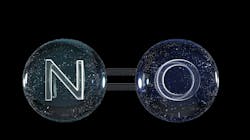Nitric oxide: An essential product of the oral microbiome
In 1998, when a situation with Monica Lewinsky hit the news, a little molecule was also making headlines. That year, two pharmacologists and a biochemist jointly won the Nobel Prize in Physiology or Medicine for the discovery that nitric oxide (NO) is a signaling molecule for the cardiovascular system. We now know that nitric oxide is an essential molecule involved in several physiological and pathological processes within the body. NO controls and regulates most cellular functions. It is involved in insulin signaling; improves sleep; lowers cholesterol; prevents high blood pressure; enhances immunity, memory, and learning; and plays a role in respiration.
Without a healthy balance of bacteria in the mouth, the body will not be able to produce enough nitric oxide. Nitric oxide helps with inflammation inhibition, the very thing we as clinicians care so much about. However, what we do in the dental chair may impede the oral microbiome and nitric oxide production. As oral health-care providers, we should be well versed in many facets of oral-systemic health and have an understanding of NO’s importance. It could make a difference for patients when guiding treatment modalities and recommendations.
What is it?
NO is a signaling molecule. That means it is used for the communication of cells in the body. Composed of one atom of nitrogen and one atom of oxygen, NO is a gas when produced in the body, and in less than a second the gas penetrates membranes and cells, sending its signals. Although technically classified as a free radical, it is critically important for blood vessel dilation.
The signaling tells arteries to relax and expand, speaks to immune cells to kill bacteria and cancer cells, and helps brain cells communicate. The main site of synthesis is in the endothelium. From there, NO diffuses to smooth muscle cells, causing relaxation. This increases blood flow and lowers blood pressure. For example, a patient who has chest pain from angina uses nitroglycerin, which is transformed into nitrite, which is converted to artery-relaxing NO in the body.
How do we make it?
One way that the body produces NO is by an enzymatic reaction that uses L-arginine, an amino acid. The enzyme is found primarily in cells that line blood vessels. When we eat proteins, they are broken down into amino acids, and L-arginine is provided to the body. With enough L-arginine, the production of NO begins. As with most body functions, it is complicated, and unfortunately, as we age, systems can become dysfunctional.
Another way the body makes nitric oxide is by eating and metabolizing inorganic nitrate found in foods such as root and leafy green vegetables, for example, beets, radishes, spinach, and garlic. (Don’t be confused with processed foods that have nitrates. Bacon, hot dogs, ham, and the like are cured with nitrite and nitrate, but offer very little free nitrate.)
Nitrate is absorbed in the gut and concentrated in the mouth, in the salivary glands. The nitrate in the food is converted to nitrite and then nitric oxide by bacteria that live in the crypts of our tongues. Fifty percent of our daily NO production is from our diet and oral bacteria. The process works in a three-way system. Consume enough nitrate from food, have the right oral bacteria, have proper stomach acid, and NO is produced.
The oral microbiome and nitric oxide
Good oral bacteria are nitrate reducers that generate nitrite as a byproduct of converting ingested nitrate-rich foods, which results in a buildup of nitrite in the saliva. Once swallowed, these nitrites mix with stomach acid to produce nitric oxide. Several commensal oral bacteria can reduce nitrate. They are from the genera Neisseria, Haemophilus, Granulicatella, Veillonella, Prevotella, Corynebacterium, Actinomyces, and Rothia.1-3 The highest activity is on the posterior of the dorsum of the tongue, especially under anaerobic conditions.1
Nitrates have been shown to prevent caries development, reduce gingival inflammation in patients with chronic gingivitis, and limit volatile sulfur compounds that result in halitosis.4-6 NO has antimicrobial activity against several periodontal pathogens such as Porphyromonas gingivalis, Prevotella intermedia, Aggregatibacter actinomycetemcomitans, and Fusobacterium nucleatum.7
While some bacteria are harmful to humans and can cause infections, most are harmless. The body needs certain types of bacteria to function, such as those that live in the digestive system. The oral microbiome is second only to the gut in the number of bacterial species present. Disruption of the oral microbiome and its bacterial communities will disrupt NO production, resulting in negative consequences.
The use of antibacterial mouthwash for seven days has been shown to reduce oral nitrite production by 90% and plasma nitrite levels by 25%.8 That same research found systolic and diastolic blood pressure elevation correlated with decreases in circulating nitrite concentrations. The loss of nitric oxide production is associated with major cardiovascular risk factors.9,10
When the leading cause of death in America is cardiovascular disease, and half of America has hypertension, these findings show an important mechanism that should be taken into consideration when recommending oral microbials. “The removal of these bacteria with an antibacterial mouthwash will very likely attenuate the NO-dependent biological effects of dietary nitrate.”11 This information has been available for more than a decade, and I personally have only recently taken it into consideration.
How to measure and how to improve
We can’t measure nitric oxide since it is a gas that vanishes so quickly. But what we can do is measure metabolites in saliva. Test strips similar to pH strips use a dab of saliva and show varying degrees of color. White registers as no metabolites and an ascending pink means increased metabolites.
To help improve NO, eat more vegetables, especially green leafy ones. (Our moms were right!) Physical exercise can enhance NO production.12 Twenty minutes three to five times a week will have benefits. A dose of sunshine provides vitamin D, which helps increase nitric oxide synthase.13 Of course, don’t smoke, watch antibiotic use, and decrease or avoid antacids—they were never designed for long-term use and disrupt the stomach acid we need for NO production.14 Using antacids for three to five years showed a 40% higher chance of heart attack or stroke. Cleaning the tongue to help the good bacteria is also worthwhile.15 Lastly, you can use supplements, but do your homework and find quality products.
NO decreases inflammation and increases blood flow, helping lower blood pressure. Over 180,000 studies show the loss of NO production is causal to chronic disease. The progression of nitrate to nitrite to nitric oxide is a synergetic relationship between the oral microbiome and the body that directly links oral and systemic health. It is always good to know more.
Author’s note: I want to thank Dr. Nathan Bryan, an international leader in molecular medicine and nitric oxide biochemistry, who reviewed this article before submission.
Editor's note: This article appeared in the April 2023 print edition of RDH magazine. Dental hygienists in North America are eligible for a complimentary print subscription. Sign up here.
References
- Doel JJ, Benjamin N, Hector MP, Rogers M, Allaker RP. Evaluation of bacterial nitrate reduction in the human oral cavity. Eur J Oral Sci. 2005;113(1):14-19. doi:10.1111/j.1600-0722.2004.00184.x
- Hyde ER, Andrade F, Vaksman Z, et al. Metagenomic analysis of nitrate-reducing bacteria in the oral cavity: implications for nitric oxide homeostasis. PLoS One. 2014;9(3):e88645. doi:10.1371/journal.pone.0088645
- Liddle L, Burleigh MC, Monaghan C, et al. Variability in nitrate-reducing oral bacteria and nitric oxide metabolites in biological fluids following dietary nitrate administration: an assessment of the critical difference. Nitric Oxide. 2019;83:1-10. doi:10.1016/j.niox.2018.12.003
- Doel JJ, Hector MP, Amirtham CV, Al-Anzan LA, Benjamin N, Allaker RP. Protective effect of salivary nitrate and microbial nitrate reductase activity against caries. Eur J Oral Sci. 2004;112(5):424-428. doi:10.1111/j.1600-0722.2004.00153.x
- Jockel-Schneider Y, Schlagenhauf U, Stölzel P, et al. Nitrate-rich diet alters the composition of the oral microbiota in periodontal recall patients. J Periodontol. 2021;92(11):1536-1545. doi:10.1002/JPER.20-0778
- Rosier BT, Buetas E, Moya-Gonzalvez EM, Artacho A, Mira A. Nitrate as a potential prebiotic for the oral microbiome. Sci Rep. 2020;10(1):12895. doi:10.1038/s41598-020-69931-x
- Backlund CJ, Sergesketter AR, Offenbacher S, Schoenfisch MH. Antibacterial efficacy of exogenous nitric oxide on periodontal pathogens. J Dent Res. 2014;93(11):1089-1094. doi:10.1177/0022034514529974
- Kapil V, Haydar SM, Pearl V, Lundberg JO, Weitzberg E, Ahluwalia A. Physiological role for nitrate-reducing oral bacteria in blood pressure control. Free Radic Biol Med. 2013;55:93-100. doi:10.1016/j.freeradbiomed.2012.11.013
- Naseem KM. The role of nitric oxide in cardiovascular diseases. Mol Aspects Med. 2005;26(1-2):33-65. doi:10.1016/j.mam.2004.09.003
- Batista RIM, Nogueira RC, Ferreira GC, et al. Antiseptic mouthwash inhibits antihypertensive and vascular protective effects of L-arginine. Eur J Pharmacol. 2021;907:174314. doi:10.1016/j.ejphar.2021.174314
- Govoni M, Jansson EA, Weitzberg E, Lundberg JO. The increase in plasma nitrite after a dietary nitrate load is markedly attenuated by an antibacterial mouthwash. Nitric Oxide. 2008;19(4):333-337. doi:10.1016/j.niox.2008.08.003
- Oral O. Nitric oxide and its role in exercise physiology. J Sports Med Phys Fitness. 2021;61(9):1208-1211. doi:10.23736/S0022-4707.21.11640-8
- Andrukhova O, Slavic S, Zeitz U, et al. Vitamin D is a regulator of endothelial nitric oxide synthase and arterial stiffness in mice. Mol Endocrinol. 2014;28(1):53-64. doi:10.1210/me.2013-1252
- Oliveira-Paula GH, Pinheiro LC, Tanus-Santos JE. Mechanisms impairing blood pressure responses to nitrite and nitrate. Nitric Oxide. 2019;85:35-43
- Tribble GD, Angelov N, Weltman R, et al. Frequency of tongue cleaning impacts the human tongue microbiome composition and enterosalivary circulation of nitrate. Front Cell Infect Microbiol. 2019;9:39. doi:10.3389/fcimb.2019.00039
About the Author

Anne O. Rice, BS, RDH, CDP, FAAOSH
Anne O. Rice, BS, RDH, CDP, FAAOSH, founded Oral Systemic Seminars after over 35 years of clinical practice and is passionate about educating the community on modifiable risk factors for dementia and their relationship to dentistry. She is a certified dementia practitioner, a longevity specialist, a fellow with AAOSH, and has consulted for Weill Cornell Alzheimer’s Prevention Clinic, FAU, and Atria Institute. Reach out to Anne at anneorice.com.
